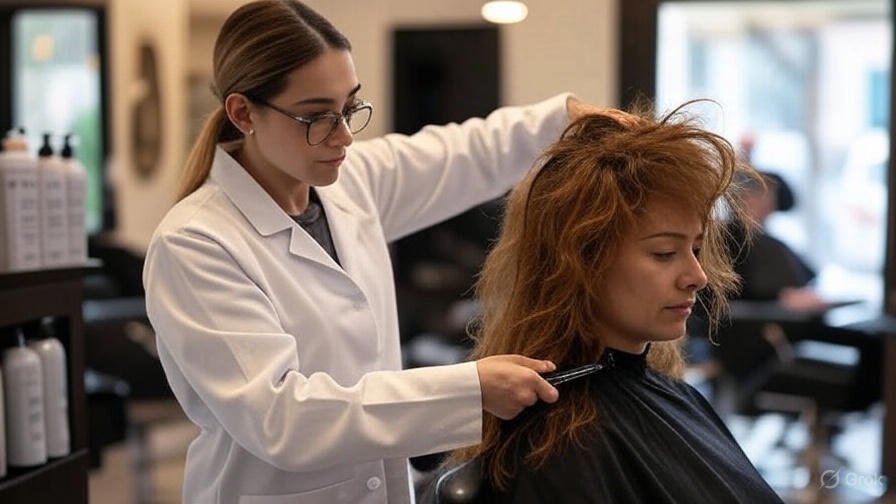The Science Behind America’s Favorite Salon Hair Treatments

Content
From the glossy blowout to the sleek keratin treatment, salon hair services have become an integral part of American beauty culture. But what exactly happens to our hair during these popular treatments? Understanding the science behind these services can help you make informed decisions about which treatments are right for your hair type and goals.
The Chemistry of Hair Structure
Before diving into specific treatments, it’s essential to understand hair’s basic structure. Each strand consists of three layers: the medulla (inner core), cortex (middle layer), and cuticle (outer protective layer). The cortex contains keratin proteins and determines hair’s strength, elasticity, and color. The cuticle acts as a protective shield, and when its scales lie flat, hair appears smooth and shiny.
Brazilian Blowout: Smoothing the Scales
The Brazilian Blowout has revolutionized frizzy hair management. This treatment involves applying a solution containing amino acids and polymerized proteins, followed by flat ironing at high temperatures (around 450°F).
The science: The heat and chemicals temporarily alter the hair’s disulfide bonds, which are responsible for curl pattern and texture. Formaldehyde or formaldehyde-releasing agents in some formulations create a temporary polymer film around each strand, sealing the cuticle and reducing frizz. The treatment typically lasts 10-12 weeks as new hair grows in.
Considerations: While effective, formaldehyde exposure has raised health concerns, leading to the development of formaldehyde-free alternatives that use different smoothing agents.
Keratin Treatment: Protein Power
Keratin treatments take smoothing a step further by infusing hair with additional keratin protein. The process involves applying a keratin-rich solution and sealing it with high-heat flat ironing.
The science: Keratin molecules fill in gaps and irregularities in the hair shaft, while heat helps the protein penetrate the cuticle layer. The treatment works by replenishing lost keratin and creating a protective coating that smooths the hair surface. Unlike permanent chemical relaxers, keratin treatments gradually wash out over 2-4 months.
Benefits: These treatments can repair damage from chemical processing, heat styling, and environmental factors while providing significant frizz reduction.
Hair Coloring: Oxidation in Action
Professional hair coloring relies on oxidation chemistry. Permanent hair color contains ammonia and hydrogen peroxide, along with color molecules called precursors.
The science: Ammonia opens the cuticle, allowing color molecules to penetrate the cortex. Hydrogen peroxide removes natural pigment and activates the color precursors, which then bond to the hair permanently. Semi-permanent colors deposit pigment on the hair surface without penetrating the cortex, gradually fading with washing.
Recent advances: Modern formulations include conditioning agents and reduced ammonia levels to minimize damage while maintaining color vibrancy and longevity.
Olaplex and Bond-Building Treatments
Olaplex has gained popularity for its ability to repair chemically damaged hair during coloring services.
The science: These treatments work by reconnecting broken disulfide bonds within the hair structure using a patented active ingredient (bis-aminopropyl diglycol dimaleate). During chemical services, hydrogen peroxide and other harsh chemicals break these bonds, leading to damage. Bond-building treatments help restore hair’s structural integrity from within.
Application: Applied during or after chemical services, these treatments can significantly reduce breakage and improve hair health without affecting color results.
Protein Treatments: Strengthening from Within
Professional protein treatments address hair weakness and breakage by infusing various proteins into the hair structure.
The science: Hydrolyzed proteins (such as keratin, collagen, or silk amino acids) are small enough to penetrate the hair cortex. Once inside, they reinforce weak spots and add structural support. The cuticle absorbs larger protein molecules, creating a protective coating.
Timing matters: Overuse can lead to protein overload, making hair feel stiff or straw-like. The key is finding the right balance for your hair type.
Deep Conditioning: Moisture Restoration
Professional deep conditioning treatments deliver intense hydration using various ingredients like ceramides, fatty acids, and humectants.
The science: These treatments work by penetrating the hair shaft to replenish lost moisture and lipids. Ingredients like panthenol (pro-vitamin B5) swell inside the cortex, while oils and butters help restore the hair’s natural lipid barrier. Heat from hooded dryers or steaming increases cuticle permeability, enhancing ingredient penetration.
Results: Improved elasticity, reduced breakage, and enhanced shine and manageability.
The Role of pH in Hair Treatments
Understanding pH is crucial for appreciating how treatments work. Healthy hair has a slightly acidic pH of 4.5-5.5.
Alkaline treatments (pH 8-12) used in permanent coloring and relaxing open the cuticle for penetration but can cause damage if not properly neutralized.
Acidic treatments (pH 3-5) close the cuticle, enhance shine, and maintain hair’s natural protective barrier. Many conditioning treatments fall into this category.
Making Informed Choices
Armed with knowledge about the science behind these treatments, you can make better decisions about which services align with your hair goals:
- For frizz control: Brazilian Blowout or keratin treatment
- For damage repair: Bond-building treatments like Olaplex
- For strength: Protein treatments for chemically processed or fine hair
- For moisture: Deep conditioning treatments for dry, coarse, or heat-damaged hair
- For color: Professional coloring services with or without bond protection
The Bottom Line
Modern salon treatments represent sophisticated applications of hair science. Understanding how these services work can help you communicate more effectively with your stylist, set realistic expectations, and maintain your results at home. Remember that hair is unique—what works wonderfully for one person may not be suitable for another. Consulting with a knowledgeable professional who understands both the science and your specific hair needs is always the best approach to achieving your desired look while maintaining hair health.
